Indus River In India Map
| Indus Sindhu / Mehran[1] | |
|---|---|
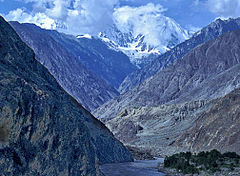 The Indus Gorge is formed as the Indus River bends effectually the Nanga Parbat massif, shown towering backside, defining the western anchor of the Himalayan mount range. | |
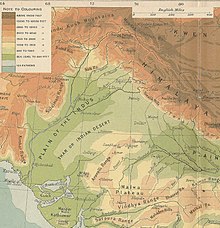 The course and major tributaries of the Indus river | |
| Location | |
| Country | Mainland china, Bharat, Pakistan Sovereignty in the Kashmir region is disputed |
| States and Provinces | Tibet Democratic Region, Ladakh, Gilgit-Baltistan, Khyber Pakhtunkhwa, Punjab, and Sindh, |
| Cities | Leh, Skardu, Dasu, Besham, Thakot, Swabi, Dera Ismail Khan, Bhakkar, Sukkur, Hyderabad, Karachi |
| Physical characteristics | |
| Source | Lake Manasarovar[2] |
| • location | Tibetan Plateau |
| Source confluence | |
| • location | Shiquanhe, Ngari Prefecture, Tibet Autonomous Region, China |
| • coordinates | 32°29′54″N 79°41′28″East / 32.49833°N 79.69111°E / 32.49833; 79.69111 |
| • elevation | 4,255 k (13,960 ft) |
| Mouth | Arabian Body of water (primary), Rann of Kutch (secondary) |
| • location | Indus River Delta (master), Islamic republic of pakistan Kori Creek (secondary), Bharat |
| • coordinates | 23°59′forty″N 67°25′51″E / 23.99444°North 67.43083°E / 23.99444; 67.43083 |
| • elevation | 0 m (0 ft) |
| Length | 3,180 km (1,980 mi)[three] |
| Bowl size | 1,120,000 km2 (430,000 sq mi)[3] |
| Discharge | |
| • location | Indus Delta, Arabian Sea, Pakistan |
| • average | 5,533 thou3/due south (195,400 cu ft/s)[4] |
| • minimum | 1,200 kthree/due south (42,000 cu ft/s) |
| • maximum | 58,000 m3/s (2,000,000 cu ft/s) |
| Discharge | |
| • location | Sukkur |
| • average | 5,673.486 one thousandthree/s (200,357.three cu ft/south)[5] |
| Discharge | |
| • location | Mithankot |
| • average | 5,812.326 one thousandthree/s (205,260.4 cu ft/s)[v] |
| Discharge | |
| • location | Tarbela Dam |
| • boilerplate | 2,469 g3/southward (87,200 cu ft/southward) |
| Basin features | |
| Tributaries | |
| • left | Zanskar River, Suru River, Soan River, Panjnad River, Ghaggar-Hakra River, Luni River |
| • right | Shyok River, Hunza River, Gilgit River, Swat River, Kunar River, Kabul River, Kurram River, Gomal River, Zhob River |
The Indus ( IN-dəs) is a transboundary river of Asia and a trans-Himalayan river of Southward and Central Asia.[6] The iii,120 km (1,940 mi)[3] river rises in mountain springs northeast of Mountain Kailash in Western Tibet, flows northwest through the disputed region of Kashmir,[7] bends sharply to the left after the Nanga Parbat massif, and flows south-past-southwest through Pakistan, before emptying into the Arabian Sea virtually the port city of Karachi.[1] [8]
The river has a total drainage area of circa 1,120,000 km2 (430,000 sq mi).[three] Its estimated almanac flow is around 243 kmthree (58 cu mi), making it one of the 50 largest rivers in the world in terms of average annual menstruation.[9] Its left-bank tributary in Ladakh is the Zanskar River, and its left-depository financial institution tributary in the plains is the Panjnad River which is formed by the successive confluences of the v Punjab rivers, namely the Chenab, Jhelum, Ravi, Beas, and Sutlej rivers. Its principal correct-banking concern tributaries are the Shyok, Gilgit, Kabul, Kurram, and Gomal rivers. Beginning in a mountain spring and fed with glaciers and rivers in the Himalayan, Karakoram, and Hindu Kush ranges, the river supports the ecosystems of temperate forests, plains, and arid countryside.
The northern role of the Indus Valley, with its tributaries, forms the Punjab region of Southern asia, while the lower course of the river ends in a large delta in the southern Sindh province of Islamic republic of pakistan. The river has historically been of import to many cultures of the region. The 3rd millennium BC saw the rise of Indus Valley civilisation, a major urban civilization of the Bronze Age. During the 2nd millennium BC, the Punjab region was mentioned in the Rigveda hymns every bit Sapta Sindhu and in the Avesta religious texts as Saptha Hindu (both terms pregnant "seven rivers"). Early historical kingdoms that arose in the Indus Valley include Gandhāra, and the Ror dynasty of Sauvīra. The Indus River came into the knowledge of the Western world early in the classical period, when Rex Darius of Persia sent his Greek discipline Scylax of Caryanda to explore the river, c. 515 BC.
Etymology and names [edit]
This river was known to the ancient Indians in Sanskrit as Sindhu and the Persians as Hindu which was regarded by both of them as "the border river".[10] [11] [12] [13] [fourteen] The variation betwixt the 2 names is explained past the Onetime Iranian sound modify *south > h, which occurred between 850 and 600 BCE co-ordinate to Asko Parpola.[15] [16] From the Western farsi Achaemenid Empire, the name passed to the Greeks as Indós (Ἰνδός).[17] It was adopted by the Romans equally Indus.[18] The name India is derived from Indus.[19] [20]
In Sindhi, this river is also known as Mehran.[i] The Ladakhis and Tibetans telephone call it Senge Tsampo, Baltis call it Gemtsuh and Tsuh-Fo, Pashtuns phone call information technology Nilab, Sher Darya and Abbasin, while Sindhis call it Purali and Samundar.[21]
The modern name in Urdu and Hindi is Sindh (Urdu: سِنْدھ , Hindi: सिंध), a semi-learned borrowing from the Sanskrit.[22]
Description [edit]
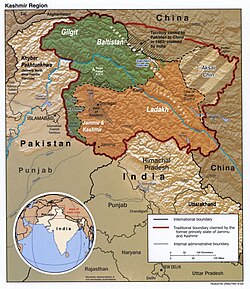
The class of the Indus in the disputed Kashmir region; the river flows through Ladakh and Gilgit-Baltistan, administered respectively by Bharat and Pakistan
The Indus River provides primal water resource for Islamic republic of pakistan'due south economy – especially the breadbasket of Punjab province, which accounts for virtually of the nation's agronomical production, and Sindh. The word Punjab means "land of v rivers" and the five rivers are Jhelum, Chenab, Ravi, Beas and Sutlej, all of which finally menstruum into the Indus. The Indus also supports many heavy industries and provides the principal supply of potable water in Pakistan.
The total length of the river varies in different sources. The length used in this commodity is iii,180 km (ane,980 mi), taken from the Himalayan Climate and Water Atlas (2015).[3] Historically, the 1909 Imperial Gazetteer of Bharat gave information technology as "just over one,800 miles".[23] A shorter figure of 2,880 km (1,790 mi) has been widely used in modern sources, as has the one of 3,180 km (1,980 mi). The modern Encyclopedia Britannica was originally published in 1999 with the shorter measurement, but was updated in 2015 to use the longer measurement.[ane] Both lengths are commonly found in modern publications; in some cases, both measurements tin be establish inside the same work.[24] An extended effigy of circa 3,600 km (2,200 mi) was announced by a Chinese research group in 2011, based on a comprehensive remeasurement from satellite imagery, and a ground expedition to identify an alternative source point, simply detailed analysis has not still been published.[25]
The ultimate source of the Indus is in Tibet, but there is some debate nearly the exact source. The traditional source of the river is the Sênggê Kanbab (Sênggê Zangbo) or "Lion's Rima oris", a perennial spring non far from the sacred Mountain Kailash, marked by a long low line of Tibetan chortens. There are several other tributaries nearby, which may peradventure form a longer stream than Sênggê Kanbab, but unlike the Sênggê Kanbab, are all dependent on snowmelt. The Zanskar River, which flows into the Indus in Ladakh, has a greater volume of water than the Indus itself before that signal.[26] An culling reckoning begins the river around 300km farther upstream, at the confluence of the Sengge Zangbo and Gar Tsangpo rivers, which bleed the Nganglong Kangri and Gangdise Shan (Gang Rinpoche, Mt. Kailash) mountain ranges. The 2011 remeasurement suggested the source was a minor lake northeast of Mount Kailash, rather than either of the ii points previously used.[25]
The Indus then flows northwest through Ladakh (Indian-administered Kashmir) and Baltistan and Gilgit (Pakistan-administered Kashmir), but south of the Karakoram range. The Shyok, Shigar and Gilgit rivers bear glacial waters into the main river. It gradually bends to the southward and descends into the Punjab plains at Kalabagh, Islamic republic of pakistan. The Indus passes gigantic gorges 4,500–5,200 metres (xv,000–17,000 ft) deep nearly the Nanga Parbat massif. Information technology flows swiftly across Hazara and is dammed at the Tarbela Reservoir. The Kabul River joins it near Attock. The balance of its route to the bounding main is in the plains of the Punjab[27] and Sindh, where the menses of the river becomes slow and highly braided. It is joined by the Panjnad at Mithankot. Across this confluence, the river, at one time, was named the Satnad River (sat = "seven", nadī = "river"), as the river now carried the waters of the Kabul River, the Indus River and the v Punjab rivers. Passing by Jamshoro, it ends in a large delta to the South of Thatta in the Sindh province of Pakistan.
The Indus is one of the few rivers in the world to exhibit a tidal bore. The Indus system is largely fed past the snowfall and glaciers of the Himalayas, Karakoram and the Hindu Kush ranges. The flow of the river is as well determined by the seasons – it diminishes profoundly in the winter, while flooding its banks in the monsoon months from July to September. There is also evidence of a steady shift in the class of the river since prehistoric times – it deviated westwards from flowing into the Rann of Kutch and adjoining Banni grasslands afterwards the 1816 convulsion.[28] [29] As of 2011[update], Indus water flows in to the Rann of Kutch during its floods breaching flood banks.[xxx]
History [edit]
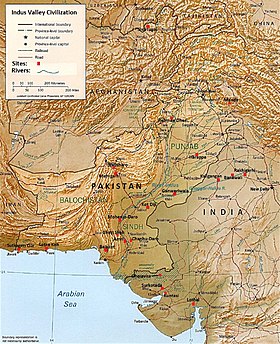
The major sites of the Indus Valley Civilization fl 2600–1900 BCE in Pakistan, India and Afghanistan
The major cities of the Indus Valley civilisation, such as Harappa and Mohenjo-daro, engagement back to effectually 3300 BC, and correspond some of the largest human habitations of the ancient world. The Indus Valley Civilisation extended from beyond northeast Afghanistan to Islamic republic of pakistan and northwest Bharat,[31] with an upward reach from e of Jhelum River to Ropar on the upper Sutlej. The coastal settlements extended from Sutkagan Dor at the Pakistan, Islamic republic of iran border to Kutch in modern Gujarat, India. There is an Indus site on the Amu Darya at Shortughai in northern Afghanistan, and the Indus site Alamgirpur at the Hindon River is located merely 28 km (17 mi) from Delhi. To engagement, over 1,052 cities and settlements have been found, mainly in the full general region of the Ghaggar-Hakra River and its tributaries. Amid the settlements were the major urban centres of Harappa and Mohenjo-daro, as well as Lothal, Dholavira, Ganeriwala, and Rakhigarhi. Only twoscore Indus Valley sites have been discovered on the Indus and its tributaries.[32] However, it is notable that majority of the Indus script seals and inscribed objects discovered were found at sites along the Indus river.[a] [33] [34]
Most scholars believe that settlements of Gandhara grave culture of the early on Indo-Aryans flourished in Gandhara from 1700 BC to 600 BC, when Mohenjo-daro and Harappa had already been abandoned.
The Rigveda describes several rivers, including i named "Sindhu". The Rigvedic "Sindhu" is idea to be the nowadays-day Indus river. It is attested 176 times in its text, 94 times in the plural, and most often used in the generic sense of "river". In the Rigveda, notably in the afterwards hymns, the significant of the give-and-take is narrowed to refer to the Indus river in particular, east.g. in the list of rivers mentioned in the hymn of Nadistuti sukta. The Rigvedic hymns apply a feminine gender to all the rivers mentioned therein, except for the Brahmaputra.
The discussion "India" is derived from the Indus River. In ancient times, "Republic of india" initially referred to those regions immediately along the east bank of the Indus, where are Punjab and Sindh at present only past 300 BC, Greek writers including Herodotus and Megasthenes were applying the term to the entire subcontinent that extends much farther east.[35] [36]
The lower bowl of the Indus forms a natural boundary between the Iranian Plateau and the Indian subcontinent; this region embraces all or parts of the Pakistani provinces Balochistan, Khyber Pakhtunkhwa, Punjab and Sindh and the countries Afghanistan and Bharat. The first West Eurasian empire to annex the Indus Valley was the Western farsi Empire, during the reign of Darius the Great. During his reign, the Greek explorer Scylax of Caryanda was deputed to explore the course of the Indus. It was crossed by the invading armies of Alexander, only after his Macedonians conquered the west depository financial institution—joining it to the Hellenic earth, they elected to retreat along the southern course of the river, ending Alexander'due south Asian campaign. Alexander's admiral Nearchus set out from the Indus Delta to explore the Persian Gulf, until reaching the Tigris River. The Indus Valley was afterward dominated by the Mauryan and Kushan Empires, Indo-Greek Kingdoms, Indo-Scythians and Hepthalites. Over several centuries Muslim armies of Muhammad bin Qasim, Mahmud of Ghazni, Mohammed Ghori, Tamerlane and Babur crossed the river to invade Sindh and Punjab, providing a gateway to the Indian subcontinent.
Geography [edit]

Tributaries [edit]
- Gar River
- Gilgit River
- Gomal River
- Hunza River
- Kabul River
- Kunar River
- Kurram River
- Panjnad River
- Chenab River
- Jhelum River
- Ravi River
- Satluj River
- Beas River
- Chenab River
- Shyok River
- Soan River
- Suru River
- Swat River
- Zanskar River
- Zhob River

Geology [edit]
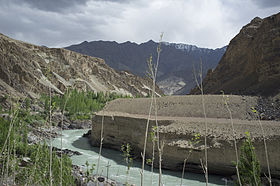
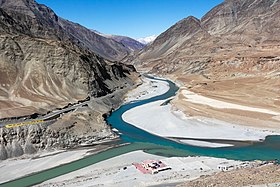
Confluence of Indus and Zanskar rivers. The Indus is at the left of the picture, flowing left-to-right; the Zanskar, carrying more h2o, comes in from the top of the picture
Indus is an antecedent river, pregnant that it existed earlier the Himalayas and entrenched itself while they were rising.
The Indus river feeds the Indus submarine fan, which is the second largest sediment body on the Earth.[37] It consists of effectually 5 one thousand thousand cubic kilometres of textile eroded from the mountains. Studies of the sediment in the modernistic river indicate that the Karakoram Mountains in northern Pakistan and India are the unmarried nigh important source of cloth, with the Himalayas providing the next largest contribution, mostly via the big rivers of the Punjab (Jhelum, Ravi, Chenab, Beas and Sutlej). Analysis of sediments from the Arabian Sea has demonstrated that prior to 5 meg years ago the Indus was not connected to these Punjab rivers which instead flowed east into the Ganga and were captured after that fourth dimension.[38] Before work showed that sand and silt from western Tibet was reaching the Arabian Body of water by 45 million years ago, implying the existence of an ancient Indus River past that time.[39] The delta of this proto-Indus river has subsequently been found in the Katawaz Basin, on the Afghan-Pakistan border.
In the Nanga Parbat region, the massive amounts of erosion due to the Indus river following the capture and rerouting through that area is thought to bring middle and lower crustal rocks to the surface.[forty]
In Nov 2011, satellite images showed that the Indus river had re-entered India, feeding Great Rann of Kutch, Petty Rann of Kutch and a lake most Ahmedabad known as Nal Sarovar.[30] Heavy rains had left the river bowl forth with the Lake Manchar, Lake Hemal and Kalri Lake (all in modern-day Pakistan) inundated. This happened 2 centuries after the Indus river shifted its grade westwards following the 1819 Rann of Kutch earthquake.
The Induan Age at start of the Triassic Flow of geological time is named for the Indus region.
Wildlife [edit]
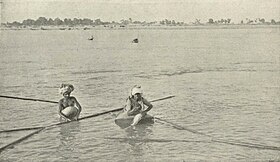
Fishermen on the Indus River, c. 1905
Accounts of the Indus valley from the times of Alexander'south entrada indicate a healthy forest cover in the region. The Mughal Emperor Babur writes of encountering rhinoceroses forth its bank in his memoirs (the Baburnama). Extensive deforestation and human being interference in the environmental of the Shivalik Hills has led to a marked deterioration in vegetation and growing conditions. The Indus valley regions are arid with poor vegetation. Agriculture is sustained largely due to irrigation works. The Indus river and its watershed has a rich biodiversity. It is home to around 25 amphibian species.[41]
Mammals [edit]
The Indus river dolphin (Platanista indicus pocket-size) is found just in the Indus River. It is subspecies of the South Asian river dolphin. The Indus river dolphin formerly also occurred in the tributaries of the Indus river. According to the World Wildlife Fund it is 1 of the almost threatened cetaceans with but about one,000 still existing.[42]
At that place are two otter species in the Indus River basin: the Eurasian otter in the northeastern highland sections and the smooth-coated otter elsewhere in the river bowl. The polish-coated otters in the Indus River stand for a subspecies institute nowhere else, the Sindh otter (Lutrogale perspicillata sindica).[43]
Fish [edit]
The Indus River basin has a high diversity, beingness the dwelling house of more than 180 freshwater fish species,[44] including 22 which are found nowhere else.[41] Fish likewise played a major role in earlier cultures of the region, including the aboriginal Indus Valley Civilisation where depictions of fish were frequent. The Indus script has a commonly used fish sign, which in its various forms may simply take meant "fish", or referred to stars or gods.[45]
In the uppermost, highest office of the Indus River bowl there are relatively few genera and species: Diptychus, Ptychobarbus, Schizopyge, Schizopygopsis and Schizothorax snowtrout, Triplophysa loaches, and the catfish Glyptosternon reticulatum.[44] Going downstream these are soon joined past the golden mahseer Tor putitora (alternatively T. macrolepis, although it often is regarded as a synonym of T. putitora) and Schistura loaches. Downriver from around Thakot, Tarbela, the Kabul–Indus river confluence, Attock Khurd and Peshawar the diversity rises strongly, including many cyprinids (Amblypharyngodon, Aspidoparia, Barilius, Chela, Cirrhinus, Crossocheilus, Cyprinion, Danio, Devario, Esomus, Garra, Labeo, Naziritor, Osteobrama, Pethia, Puntius, Rasbora, Salmophasia, Securicula and Systomus), true loaches (Botia and Lepidocephalus), stone loaches (Acanthocobitis and Nemacheilus), ailiid catfish (Clupisoma), bagridae catfish (Batasio, Mystus, Rita and Sperata), airsac catfish (Heteropneustes), schilbid catfish (Eutropiichthys), silurid catfish (Ompok and Wallago), sisorid catfish (Bagarius, Gagata, Glyptothorax and Sisor), gouramis (Trichogaster), nandid leaffish (Nandus), snakeheads (Channa), spiny eel (Macrognathus and Mastacembelus), knifefish (Notopterus), glassfish (Chanda and Parambassis), clupeids (Gudusia), needlefish (Xenentodon) and gobies (Glossogobius), equally well equally a few introduced species.[44] Equally the altitude further declines the Indus basin becomes overall quite tedious-flowing as information technology passes through the Punjab Patently. Major carp become mutual, and chameleonfish (Badis), mullet (Sicamugil) and swamp eel (Monopterus) announced.[44] In some upland lakes and tributaries of the Punjab region snowtrout and mahseer are notwithstanding common, but once the Indus basin reaches its lower plain the quondam group is entirely absent-minded and the latter are rare.[44] Many of the species of the middle sections of the Indus basin are also present in the lower. Notable examples of genera that are present in the lower plain but generally not elsewhere in the Indus River basin are the Aphanius pupfish, Aplocheilus killifish, palla fish (Tenualosa ilisha), catla (Labeo catla), rohu (Labeo rohita) and Cirrhinus mrigala.[44] The lowermost part of the river and its delta are domicile to freshwater fish, simply also a number of stagnant and marine species.[44] This includes pomfret and prawns. The big delta has been recognized past conservationists as an important ecological region. Here, the river turns into many marshes, streams and creeks and meets the ocean at shallow levels.
Palla fish (Tenualosa ilisha) of the river is a effeminateness for people living along the river. The population of fish in the river is moderately high, with Sukkur, Thatta, and Kotri existence the major fishing centres – all in the lower Sindh grade. As a result, damming and irrigation has made fish farming an important economic activity.
Economy [edit]

Skyline of Sukkur along the shores of the Indus River
The Indus is the most important supplier of h2o resource to the Punjab and Sindh plains – it forms the backbone of agriculture and nutrient product in Pakistan. The river is especially critical since rainfall is meagre in the lower Indus valley. Irrigation canals were showtime built by the people of the Indus Valley culture, and later by the engineers of the Kushan Empire and the Mughal Empire. Modern irrigation was introduced past the British East Bharat Visitor in 1850 – the construction of modern canals accompanied with the restoration of old canals. The British supervised the construction of i of the most complex irrigation networks in the world. The Guddu Avalanche is one,350 m (four,430 ft) long – irrigating Sukkur, Jacobabad, Larkana and Kalat. The Sukkur Avalanche serves over 20,000 kmtwo (vii,700 sq mi).
Later Pakistan came into existence, a water control treaty signed between India and Pakistan in 1960 guaranteed that Pakistan would receive water from the Indus River and its two tributaries the Jhelum River & the Chenab River independently of upstream control by Republic of india.[46]
The Indus Basin Project consisted primarily of the structure of two main dams, the Mangla Dam built on the Jhelum River and the Tarbela Dam constructed on the Indus River, together with their subsidiary dams.[47] The Islamic republic of pakistan Water and Power Development Authorisation undertook the construction of the Chashma-Jhelum link canal – linking the waters of the Indus and Jhelum rivers – extending water supplies to the regions of Bahawalpur and Multan. Pakistan constructed the Tarbela Dam near Rawalpindi – standing two,743 metres (9,000 ft) long and 143 metres (470 ft) loftier, with an 80-kilometre (50 mi) long reservoir. It supports the Chashma Barrage virtually Dera Ismail Khan for irrigation use and overflowing command and the Taunsa Barrage near Dera Ghazi Khan which besides produces 100,000 kilowatts of electricity. The Kotri Barrage about Hyderabad is 915 metres (iii,000 ft) long and provides additional water supplies for Karachi. The extensive linking of tributaries with the Indus has helped spread water resources to the valley of Peshawar, in the Khyber Pakhtunkhwa. The extensive irrigation and dam projects provide the basis for Pakistan's large production of crops such as cotton wool, sugarcane and wheat. The dams likewise generate electricity for heavy industries and urban centers.
People [edit]
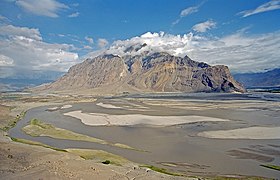
Indus river is sacred to Hindus.[48] [49] Sindhu Darshan Festival is held on every Guru Purnima on the banks of Indus.[50]
The ethnicities of the Indus Valley (Islamic republic of pakistan and Northwest Republic of india) have a greater amount of ANI (or W Eurasian) admixture than other Due south Asians, including inputs from Western Steppe Herders, with evidence of more than sustained and multi-layered migrations from the west.[51]
Modern issues [edit]
Indus delta [edit]
Originally, the delta used to receive about all of the h2o from the Indus river, which has an annual flow of approximately 180 billion cubic metres (240×10 ^ 9 cu yd), and is accompanied by 400 meg tonnes (390×x ^ half dozen long tons) of silt.[52] Since the 1940s, dams, barrages and irrigation works have been synthetic on the river. The Indus Basin Irrigation System is the "largest face-to-face irrigation arrangement developed over the past 140 years" anywhere in the world.[53] This has reduced the menstruation of h2o and past 2018, the boilerplate annual catamenia of water beneath the Kotri avalanche was 33 billion cubic metres (43×10 ^ 9 cu yd),[54] and annual amount of silt discharged was estimated at 100 million tonnes (98×10 ^ 6 long tons).[ commendation needed ] As a result, the 2010 Pakistan floods were considered "good news" for the ecosystem and population of the river delta as they brought much needed fresh h2o.[55] [56] Any further utilization of the river basin water is not economically feasible.[57] [58]
Vegetation and wildlife of the Indus delta are threatened past the reduced inflow of fresh water, along with extensive deforestation, industrial pollution and global warming. Damming has also isolated the delta population of Indus river dolphins from those further upstream.[59]
Large-scale diversion of the river'south water for irrigation has raised far-reaching problems. Sediment bottleneck from poor maintenance of canals has afflicted farm production and vegetation on numerous occasions. Irrigation itself is increasing soil salinization, reducing crop yields and in some cases rendering farmland useless for cultivation.[60]
Effects of climatic change on the river [edit]
The Tibetan Plateau contains the earth's tertiary-largest store of water ice. Qin Dahe, the former head of the China Meteorological Assistants, said the recent fast step of melting and warmer temperatures will be good for agriculture and tourism in the short term, but issued a potent warning:
-
- "Temperatures are rising 4 times faster than elsewhere in People's republic of china, and the Tibetan glaciers are retreating at a higher speed than in any other part of the world... In the brusque term, this will cause lakes to expand and bring floods and mudflows.. In the long run, the glaciers are vital lifelines of the Indus River. Once they vanish, water supplies in Pakistan will be in peril."[61]
"There is insufficient data to say what will happen to the Indus," says David Grey, the Earth Banking concern's senior water advisor in Southern asia. "Merely we all have very nasty fears that the flows of the Indus could exist severely, severely afflicted by glacier melt every bit a upshot of climatic change," and reduced past perhaps as much equally fifty percent. "Now what does that mean to a population that lives in a desert [where], without the river, there would be no life? I don't know the answer to that question," he says. "But we need to be concerned about that. Deeply, deeply concerned."
U.S. diplomat Richard Holbrooke said, shortly before his death in 2010, that he believed that falling water levels in the Indus River "could very well precipitate Earth War Three."[62]
Pollution [edit]
Over the years factories on the banks of the Indus River have increased levels of water pollution in the river and the atmosphere around it. Loftier levels of pollutants in the river have led to the deaths of endangered Indus river dolphin. The Sindh Environmental Protection Agency has ordered polluting factories around the river to shut down under the Pakistan Environmental Protection Act, 1997.[63] Death of the Indus river dolphin has besides been attributed to fishermen using poison to impale fish and scooping them up.[64] [65] As a consequence, the regime banned angling from Guddu Barrage to Sukkur.[66]
The Indus is second among a group of ten rivers responsible for about 90% of all the plastic that reaches the oceans. The Yangtze is the only river contributing more plastic.[67] [68]
2010 floods [edit]

Affected areas as of 26 Baronial 2010
Oftentimes, Indus river is decumbent to moderate to severe flooding.[69] In July 2010, post-obit abnormally heavy monsoon rains, the Indus River rose higher up its banks and started flooding. The rain connected for the next two months, devastating large areas of Islamic republic of pakistan. In Sindh, the Indus outburst its banks near Sukkur on 8 August, submerging the village of Mor Khan Jatoi.[70] In early August, the heaviest flooding moved southward along the Indus River from severely afflicted northern regions toward western Punjab, where at least 1,400,000 acres (570,000 ha) of cropland was destroyed, and the southern province of Sindh.[71] Every bit of September 2010[update], over two thousand people had died and over a million homes had been destroyed since the flooding began.[72] [73]
2011 floods [edit]
The 2011 Sindh floods began during the Pakistani monsoon season in mid-Baronial 2011, resulting from heavy monsoon rains in Sindh, eastern Balochistan, and southern Punjab.[74] The floods caused considerable damage; an estimated 434 civilians were killed, with 5.three meg people and 1,524,773 homes affected.[75] Sindh is a fertile region and ofttimes called the "breadbasket" of the state; the damage and toll of the floods on the local agrarian economy was said to exist extensive. At least 1.7 million acres (690,000 ha; 2,700 sq mi) of arable land were inundated. The flooding followed the previous year'south floods, which devastated a large part of the country.[75] Unprecedented torrential monsoon rains acquired severe flooding in 16 districts of Sindh.[76]
Barrages, bridges, levees and dams [edit]
In Islamic republic of pakistan currently at that place are six barrages on the Indus: Guddu Barrage, Sukkur Barrage, Kotri Barrage (also chosen Ghulam Muhammad barrage), Taunsa Avalanche, Chashma Avalanche and Jinnah Barrage. Some other new barrage called "Sindh Avalanche" is planned as a concluding barrage on the Indus River.[77] [78] In that location are some bridges on river Indus, such as, Dadu Moro Bridge, Larkana Khairpur Indus River Bridge, Thatta-Sujawal bridge, Jhirk-Mula Katiar bridge and recently planned Kandhkot-Ghotki span.[79]
The unabridged left banking company of Indus river in Sind province is protected from river flooding past amalgam around 600 km long levees. The right bank side is too leveed from Guddu avalanche to Lake Manchar.[80] In response to the levees construction, the river has been aggrading rapidly over the final 20 years leading to breaches upstream of barrages and inundation of large areas.[81]
Tarbela Dam in Pakistan is synthetic on the Indus River, while the controversial Kalabagh dam is also being synthetic on Indus river. Islamic republic of pakistan is also building Munda Dam.
Gallery [edit]
-
Video of River Indus at Kotri Avalanche, Sindh, Islamic republic of pakistan.
-

Lansdowne Bridge and Ayub Span connecting the cities of Rohri and Sukkur in Sindh, Pakistan.
-
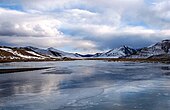
Frozen Indus, Near Nyoma
-
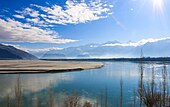
Indus at Skardu
-

Indus near Dera Ismail Khan
See also [edit]
- List of rivers of Pakistan
- Baglihar Dam
- Ghaggar-Hakra River
- Geology of the Himalaya
- HMS Indus
- Indus River Delta
- Indus Valley civilization
- Indus Waters Treaty
- Rivers of Jammu and Kashmir
- Sarasvati River
- Sindh Sagar Doab
- Sindhology
- Sindhu Darshan Festival
- Sindhu Pushkaram
- Rigvedic rivers
Notes [edit]
- ^ Number of Indus script inscribed objects and seals obtained from various Harappan sites: 1540 from Mohanjodaro, 985 from Harappa, 66 from Chanhudaro, 165 from Lothal, 99 from Kalibangan, 7 from Banawali, six from Ur in Republic of iraq, 5 from Surkotada, 4 from Chandigarh
References [edit]
- ^ a b c d Ahmad, Nafis; Lodrick, Deryck (6 February 2019). "Indus River". Encyclopedia Britannica . Retrieved 5 February 2021.
- ^ Ahmad, Ijaz; Zhang, Fan; Tayyab, Muhammad; Anjum, Muhammad Naveed; Zaman, Muhammad; Liu, Junguo; Farid, Hafiz Umar; Saddique, Qaisar (15 November 2018). "Spatiotemporal assay of atmospheric precipitation variability in almanac, seasonal and extreme values over upper Indus River bowl". Atmospheric Inquiry. 213: 346–lx. Bibcode:2018AtmRe.213..346A. doi:10.1016/j.atmosres.2018.06.019. ISSN 0169-8095. S2CID 125980503.
- ^ a b c d east Shrestha, AB; Agrawal, NK; Alfthan, B; Bajracharya, SR; Maréchal, J; van Oort, B (ed.). The Himalayan Climate and Water Atlas: Bear on of Climatic change on H2o Resources in Five of Asia's Major River Basins. ICIMOD, Grid-Arendal and CICERO. p. 58. ISBN978-92-9115-357-two.
{{cite book}}: CS1 maint: multiple names: editors list (link) - ^ Amir, Khan; Naresh, Pant; Anuj, Goswami; Ravish, Lal; Rajesh, Joshi (December 2015). "Critical Evaluation and Cess of Boilerplate Annual Precipitation in The Indus, The Ganges and The Brahmaputra Basins, Northern India - Himalayan Cryospheric Observations and Modelling (HiCOM)".
- ^ a b "Rivers Network". 2020.
- ^ Richardson, Hugh East.; Wylie, Turrell Five.; Falkenheim, Victor C.; Shakabpa, Tsepon W. D. (3 March 2020). "Tibet". Encyclopedia Britannica . Retrieved 9 August 2021.
historic region and autonomous region of People's republic of china that is often chosen "the roof of the world." It occupies a vast area of plateaus and mountains in Central Asia
- ^ "Kashmir: region, Indian subcontinent". Encyclopædia Britannica . Retrieved 16 July 2016. Quote: "Kashmir, region of the northwestern Indian subcontinent. It is bounded by the Uygur Autonomous Region of Xinjiang to the northeast and the Tibet Autonomous Region to the e (both parts of China), past the Indian states of Himachal Pradesh and Punjab to the s, past Pakistan to the west, and by Transitional islamic state of afghanistan to the northwest. The northern and western portions are administered past Pakistan and comprise three areas: Azad Kashmir, Gilgit, and Baltistan, ... The southern and southeastern portions constitute the Indian state of Jammu and Kashmir. The Indian- and Pakistani-administered portions are divided past a "line of control" agreed to in 1972, although neither land recognizes information technology as an international boundary. In addition, Communist china became active in the eastern area of Kashmir in the 1950s and since 1962 has controlled the northeastern function of Ladakh (the easternmost portion of the region)."
- ^ Natural Wonders of the Earth. Penguin Random House/DK & Smithsonian. 2017. p. 240. ISBN978-1-4654-9492-4.
- ^ "Indus water flow data in to reservoirs of Islamic republic of pakistan". Archived from the original on 6 August 2017. Retrieved 15 August 2017.
- ^ Witzel, Michael (1995). "Early Indian history: Linguistic and textual parameters". In Erdosy, George (ed.). The Indo-Aryans of Ancient South asia: Language, Material Culture and Ethnicity. Walter de Gruyter. pp. 85–125. ISBN978-three-11-014447-five.
- ^ Thieme, P. (1970). "Sanskrit sindu-/Sindhu- and Old Iranian hindu-/Hindu-". In Mary Boyce; Ilya Gershevitch (eds.). W. B. Henning memorial volume. Lund Humphries. p. 450. ISBN9780853312550. : "As the corking frontier river that represents the natural dividing line between India and Iran, the Indus could nigh easily and fittingly be chosen Sindhu- 'Borderland' by the Indians and Hindu- 'Frontier' by the Iranians."
- ^ Osada, Toshiki (2006). Indus Culture: Text & Context. Manohar Publishers & Distributors. p. 100. ISBN978-81-7304-682-7. : 'P. Theme (1991) understood the Indus as the "border river" dividing IA and Islamic republic of iran. tribes and has derived it from IE with an etymology from the root "si(n)dh" to divide."'
- ^ Boyce, Mary (1989). A History of Zoroastrianism: The Early Period. BRILL. pp. 136–. ISBN978-xc-04-08847-iv. : "The word hindu- (Skt. sindhu-), used thus to mean a river-frontier of the inhabited world, was also practical more often than not, information technology seems, to whatever big river which, similar the Indus, formed a natural frontier betwixt peoples or lands."
- ^ Bailey, H. W. (1975). "Indian Sindhu-, Iranian Hindu- (Notes and Communications)". Message of the Schoolhouse of Oriental and African Studies. 38 (three): 610–611. doi:10.1017/S0041977X00048138. JSTOR 613711. S2CID 163083563. : "The word sindhu- is used of a 'mass of water' (samudra-), not therefore primarily 'flowing' water. Hence the second derivation of 'enclosed banks' is conspicuously preferable."
- ^ Parpola 2015, Affiliate 9. sfn error: no target: CITEREFParpola2015 (assistance)
- ^ Prasad, R.U.Due south. (25 May 2017). River and Goddess Worship in India: Changing Perceptions and Manifestations of Sarasvati. Taylor & Francis. pp. 23–. ISBN978-1-351-80655-8.
- ^ Mukherjee, Bratindra Nath (2001). Nationhood and Statehood in Bharat: A historical survey. Regency Publications. p. iii. ISBN978-81-87498-26-1. : "Patently the same territory was referred to as Hello(n)du(sh) in the Naqsh‐i‐Rustam inscription of Darius I every bit one of the countries in his empire.[10] The terms Hindu and India ('Indoi) indicate an original indigenous expression like Sindhu. The proper name Sindhu could have been pronounced by the Persians as Hindu (replacing southward past h and dh past d) and the Greeks would have transformed the latter as Indo‐ (Indoi, Latin Indica, India) with h dropped..."
- ^ Charlton T Lewis; Charles Curt (1879). A Latin Dictionary. New York, N.Y.; Cincinnati, Ohio; Chicago, Ill.: American Volume Company; Oxford: Clarendon Press. p. sv. Indus.
- ^ India (noun), Oxford English Dictionary, 3rd Edition, 2009 (subscription required)
- ^ Thieme, P. (1970), "Sanskrit sindu-/Sindhu- and Old Iranian hindu-/Hindu-", in Mary Boyce; Ilya Gershevitch (eds.), W. B. Henning memorial volume, Lund Humphries, pp. 447–450, ISBN978-0-85331-255-0
- ^ Albinia, Alice (28 August 2008). "The guardian beginning volume award longlist: Empires of the Indus by Alice Albinia". the Guardian . Retrieved 19 May 2022.
- ^ McGregor, Ronald Stuart (1993). The Oxford Hindi-English Dictionary, London: Oxford Academy Press. p. 1012.
- ^ Royal Gazetteer of India. Vol. 13. Oxford University Printing. 1909. p. 357.
- ^ For example, The Indus River : biodiversity, resources, humankind. Karachi: Oxford University Press. 1999. ISBN0195779053. Papers in this edited collection generally use the shorter measurement, only at least ii use the longer one.
- ^ a b "Earthly matters: Origins of the Indus". Dawn. 4 September 2011.
- ^ Albinia (2008), p. 307.
- ^ Holdich, Thomas Hungerford (1911). . In Chisholm, Hugh (ed.). Encyclopædia Britannica. Vol. fourteen (11th ed.). Cambridge University Press. pp. 507–508.
- ^ lxx% of cattle-breeders desert Banni; by Narandas Thacker, TNN, 14 February 2002; The Times of India
- ^ "564 Charul Bharwada & Vinay Mahajan, Lost and forgotten: grasslands and pastoralists of Gujarat".
- ^ a b "Indus re-enters India after ii centuries, feeds Petty Rann, Nal Sarovar". Retrieved 22 December 2017.
- ^ Williams, Brian (2016). Daily Life in the Indus Valley Civilization. Raintree. p. 6. ISBN978-1406298574.
- ^ Malik, Dr Malti (1943). History of India. New Saraswati House Republic of india Pvt Ltd. p. 12. ISBN978-81-7335-498-4.
- ^ Iravatham Mahadevan, 1977, The Indus Script: Text, Concordance and Tables, pp. 6-7
- ^ Upinder Singh, 2008, A History of Ancient and Early on Medieval India From the Stone Age to the 12th Century, p. 169
- ^ Henry Yule: India, Indies Archived 28 June 2012 at archive.today. In Hobson-Jobson: A glossary of colloquial Anglo-Indian words and phrases, and of kindred terms, etymological, historical, geographical and discursive. New ed. edited by William Crooke, B.A. London: J. Murray, 1903
- ^ "Was the Ramayana actually set in and effectually today'southward Afghanistan?".
- ^ Clift; Gaedicke; Edwards; Lee; Hildebrand; Amjad; White; and Schlüter (2002). "The stratigraphic development of the Indus Fan and the history of sedimentation in the Arabian Bounding main". Marine Geophysical Researches. 23 (3): 223–245. Bibcode:2002MarGR..23..223C. doi:x.1023/A:1023627123093. S2CID 129735252.
{{cite journal}}: CS1 maint: uses authors parameter (link) - ^ Clift, Peter D.; Blusztajn, Jerzy (15 December 2005). "Reorganization of the western Himalayan river system later 5 million years ago". Nature. 438 (7070): 1001–1003. Bibcode:2005Natur.438.1001C. doi:10.1038/nature04379. PMID 16355221. S2CID 4427250.
- ^ Clift, Peter D.; Shimizu, N.; Layne, G.D.; Blusztajn, J.S.; Gaedicke, C.; Schlüter, H.-U.; Clark, Yard.Yard.; Amjad, S. (August 2001). "Evolution of the Indus Fan and its significance for the erosional history of the Western Himalaya and Karakoram". GSA Bulletin. 113 (8): 1039–1051. Bibcode:2001GSAB..113.1039C. doi:10.1130/0016-7606(2001)113<1039:DOTIFA>two.0.CO;two.
- ^ Zeitler, Peter K.; Koons, Peter O.; Bishop, Michael P.; Chamberlain, C. Page; Craw, David; Edwards, Michael A.; Hamidullah, Syed; Jam, Qasim M.; Kahn, M. Asif; Khattak, K. Umar Khan; Kidd, William S. F.; Mackie, Randall L.; Meltzer, Anne South.; Park, Stephen Yard.; Pecher, Arnaud; Poage, Michael A.; Sarker, Golam; Schneider, David A.; Seeber, Leonardo; Shroder, John F. (Oct 2001). "Crustal reworking at Nanga Parbat, Islamic republic of pakistan: Metamorphic consequences of thermal-mechanical coupling facilitated by erosion". Tectonics. 20 (5): 712–728. Bibcode:2001Tecto..xx..712Z. doi:10.1029/2000TC001243.
- ^ a b "Indus River" (PDF). Earth' top 10 rivers at risk. WWF. Archived from the original (PDF) on 4 October 2012. Retrieved xi July 2012.
- ^ "WWF – Indus River Dolphin". Wwf.panda.org. Retrieved 22 September 2012.
- ^ Khan, W.A.; Bhagat, H.B. (2010). "Otter Conservation in Pakistan". IUCN Otter Spec. Grouping Bull. 27 (2): 89–92.
- ^ a b c d e f thousand Mirza, 1000.R.; Mirza, Z.South. (2014). "Longitudinal Zonation in the Fish Creature of the Indus River in Pakistan". Biologia (Islamic republic of pakistan). 60 (ane): 149–152.
- ^ Sparavigna, A. (2008). Icons and signs from the ancient Harappa. Dipartimento di Fisica, Politecnico di Torino.
- ^ "Tarabela Dam". structurae.the cat in the hat. Retrieved nine July 2007.
- ^ "Indus Basin Projection". Encyclopædia Britannica . Retrieved 9 July 2007.
- ^ Kapoor, Subodh (2002). The Indian Encyclopaedia: Hinayana-India (Central India). Cosmo Publications. ISBN978-81-7755-267-half-dozen.
- ^ Basu, Baman Das (2007). The Sacred books of the Hindus. Cosmo Publications. ISBN978-81-307-0533-0.
- ^ "Corona effect: Simply Sindhis allowed for Sindhu Darshan Fest". Retrieved 24 October 2020.
- ^ Pathak, Ajai K.; Kadian, Anurag; Kushniarevich, Alena; Montinaro, Francesco; Mondal, Mayukh; Ongaro, Linda; Singh, Manvendra; Kumar, Pramod; Rai, Niraj; Parik, Jüri; Metspalu, Ene (half-dozen Dec 2018). "The Genetic Ancestry of Modernistic Indus Valley Populations from Northwest India". The American Journal of Human Genetics. 103 (6): 918–929. doi:x.1016/j.ajhg.2018.10.022. ISSN 0002-9297. PMC6288199. PMID 30526867.
- ^ "Indus Delta, Pakistan: economic costs of reduction in freshwater flow" (PDF). International Spousal relationship for Conservation of Nature. May 2003. Archived from the original (PDF) on 16 November 2011. Retrieved 9 July 2018.
- ^ Sarfraz Khan Quresh (March 2005). "Water, Growth and Poverty in Islamic republic of pakistan" (PDF). World Bank.
- ^ "Pakistan'south h2o economy: getting the residuum right". July 2018.
- ^ Walsh, Declan (21 October 2010). "Pakistan floods: The Indus delta". The Guardian.
- ^ Walsh, Declan (five October 2010). "Pakistan's floodwaters welcomed forth Indus delta". The Guardian.
- ^ Keller, Jack; Keller, Andrew; Davids, Grant (January 1998). "River basin evolution phases and implications of closure". Retrieved 25 September 2020.
- ^ "Integrated Water Resource Systems: Theory and Policy Implications" (PDF) . Retrieved 22 June 2018.
- ^ "Indus River Delta". Earth Wildlife Fund. Archived from the original on 23 January 2012.
- ^ "Technology Breakthroughs for Global H2o Security: A Deep Dive into Southern asia". 12 September 2018. Retrieved 24 December 2018.
- ^ "Global warming benefits to Tibet: Chinese official. Reported eighteen August 2009". 17 August 2009. Archived from the original on 23 January 2010. Retrieved 4 December 2012.
- ^ Farrow, Ronan (2018). War on Peace: The Stop of Affairs and the Decline of American Influence. Westward. W. Norton. ISBN978-0393652109.
- ^ "SEPA orders polluting mill to finish production". Dawn. iii Dec 2008. Retrieved 28 June 2012.
- ^ "Fishing toxicant killing Indus dolphins, PA told". Dawn. 8 March 2012. Retrieved 27 Apr 2016.
- ^ "eighteen dolphins died from poisoning in January". Dawn. 1 May 2012. Retrieved 28 June 2012.
- ^ "Threat to dolphin: Govt bans line-fishing between Guddu and Sukkur". The Limited Tribune. 9 March 2012. Retrieved 28 June 2012.
- ^ "Near all plastic in the ocean comes from just ten rivers - 30.eleven.2017". DW.COM . Retrieved 22 August 2018.
about ninety percent of all the plastic that reaches the world'due south oceans gets flushed through just 10 rivers: The Yangtze, the Indus, Yellow River, Hai River, the Nile, the Ganges, Pearl River, Amur River, the Niger, and the Mekong (in that guild).
- ^ Schmidt, Christian; Krauth, Tobias; Wagner, Stephan (11 Oct 2017). "Export of Plastic Debris by Rivers into the Ocean" (PDF). Environmental Science & Technology. American Chemical Club (ACS). 51 (21): 12246–12253. Bibcode:2017EnST...5112246S. doi:10.1021/acs.est.7b02368. ISSN 0013-936X. PMID 29019247.
- ^ "Indus Basin Floods" (PDF). Asian Development Bank. 2013. Retrieved 20 Nov 2018.
- ^ Bodeen, Christopher (viii August 2010). "Asia flooding plunges millions into misery". Associated Press. Retrieved 8 Baronial 2010.
- ^ Guerin, Orla (7 August 2010). "Pakistan issues flooding 'red alarm' for Sindh province". British Dissemination Corporation. Retrieved seven Baronial 2010.
- ^ "BBC News – Pakistan floods: Earth Banking concern to lend $900m for recovery". bbc.co.u.k.. 17 August 2010. Retrieved 24 August 2010.
- ^ "BBC News – Millions of Islamic republic of pakistan children at risk of flood diseases". bbc.co.u.k.. 16 August 2010. Retrieved 24 August 2010.
- ^ "Islamic republic of pakistan floods: Oxfam launches emergency assistance response". BBC Globe News South Asia. xiv September 2011. Retrieved xv September 2011.
- ^ a b "Floods worsen, 270 killed: officials". The Express Tribune. xiii September 2011. Retrieved 13 September 2011.
- ^ Government of Pakistan Pakmet.com.pk Retrieved on xix September 2011 Archived 24 Apr 2012 at the Wayback Motorcar
- ^ "PM okays Indus river barrage to mitigate water woes". Retrieved 8 August 2019.
- ^ "Center announces Rs125bn Sindh avalanche project". Retrieved 24 Baronial 2019.
- ^ "Government to launch Kandhkot-Ghotki bridge over River Indus adjacent calendar month: Sindh CM". The Express Tribune. Retrieved 1 August 2016.
- ^ "Restore Pakistan's rivers, handle floods, droughts and climate change". Retrieved 29 July 2019.
- ^ "Pakistan: Getting More from Water (see Page 50)" (PDF). Earth Depository financial institution. Retrieved 29 March 2019.
Bibliography [edit]
- Albinia, Alice. (2008) Empires of the Indus: The Story of a River. Showtime American Edition (20101) W. W. Norton & Company, New York. ISBN 978-0-393-33860-seven.
- Alexander Burnes, A voyage on the Indus, London, 1973
- Philippe Fabry, Wandering with the Indus, with Yusuf Shahid (text) Lahore, 1995
- Jean Fairley, The Panthera leo River: The Indus, London, 1975
- Thou.P. Malalasekera (1 September 2003). Dictionary of Pali Proper Names, Volume 1. Asian Educational Services. ISBN978-81-2061-823-vii.
{{cite volume}}: CS1 maint: ref duplicates default (link) - D. Murphy, Where the Indus is Young, London, 1977
- Samina Quraeshi, Legacy of the Indus, New York, 1974
- Schomberg, Betwixt Oxus and Indus, London, 1935
- Francine Tissot, Les Arts anciens du Pakistan et de l'Afghanistan, Paris, 1987
- Sir M. Wheeler, Civilisations of the Indus Valley and Beyond, London, 1966
- Globe Atlas, Millennium Edition, p. 265.
External links [edit]
- The origins of Indus:
- 1159539 Gar basin on OpenStreetMap
- 1159538 Sengge basin on OpenStreetMap
- Northern Areas Development Gateway
- The Mountain Areas Conservancy Project - covered parts of the Indus River
- Indus River watershed map (World Resources Institute) Archived 13 Apr 2005 at the Wayback Machine
- Indus Wildlife at the Wayback Automobile (archived 7 October 2006)
- Pulitzer Eye on Crisis Reporting'south project on water problems in South Asia
Indus River In India Map,
Source: https://en.wikipedia.org/wiki/Indus_River
Posted by: fosterfenly1938.blogspot.com


0 Response to "Indus River In India Map"
Post a Comment